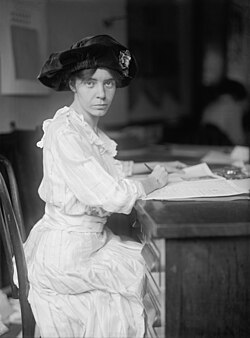Alice Paul

"I never doubted that equal rights was the right direction. Most reforms, most problems are complicated. But to me there is nothing complicated about ordinary equality."
She was born on January 11, 1885, at Paulsdale, her family farm in Mount Laurel Township, New Jersey. Alice was the eldest of four children of William Mickle Paul I and Tacie Paul. Her father was a wealthy businessman and her mother was a suffragist and brought Alice with her to women’s suffrage meetings. Both her parents embraced gender equality, education for women, and working to improve society. Her ancestors included participants in the New Jersey Committee of Correspondence in the Revolutionary era and a state legislative leader in the 19th century. Alice was also descendant of William Penn, the Quaker founder of Pennsylvania.
Alice graduated at the top of her class from Moorestown Friends School. She then attended Swarthmore College, a Quaker school cofounded by her grandfather. It was the same institution her mother had attended as one of the first women educated there. While attending Swarthmore, Alice served as a member on the Executive Board of Student Government. She graduated in 1905 with a bachelor's degree in biology.
After graduation Alice completed a fellowship year at a settlement house in New York City. Living and working at the settlement house taught her about the need to right injustice in America.
After graduation Alice completed a fellowship year at a settlement house in New York City. Living and working at the settlement house taught her about the need to right injustice in America.
She went on to attend the New York School of Philanthropy (now Columbia University) and received a Master of Arts degree in sociology in 1907.
Alice then went to England to continue her studies at the Woodbrooke Quaker Study Centre in Birmingham. She also took economics classes from the University of Birmingham, while continuing to earn money doing social work. While in England, Alice met American Lucy Burns, and joining the women’s suffrage efforts there, they learned militant protest tactics. Alice was arrested on several occasions, serving time in jail and going on a hunger strike.
In 1912, Alice and Lucy joined the National American Woman Suffrage Association and served s the chair of it's congressional committee. They then organized a huge women’s suffrage march in DC on the eve of the inauguration of Woodrow Wilson. Approximately eight thousand women marched with banners and floats down Pennsylvania Avenue from the Capitol to the White House, while a half million spectators watched, supported and harassed the marchers.
On March 17, 1913, Paul and other suffragists met with Wilson, who said it was not yet time for an amendment to the Constitution.
In January of 1917, Alice and other NWP members that called themselves "Silent Sentinels", stood silently at the White House gates, picketing for women’s suffrage. They carried signs that read, “MR. PRESIDENT, HOW LONG MUST WOMEN WAIT FOR LIBERTY?” “MR. PRESIDENT, WHAT WILL YOU DO FOR WOMAN SUFFRAGE?”
On November 27 and 28 of 1917, all the suffragists were released from prison.
In 1918, After the bad publicity that ensued, President Wilson gave his support for a constitutional amendment giving women the right to vote.
On August 26th, 1920, the Nineteenth Amendment became law on. A federal court had also thrown out charges against the pickets, and permits to demonstrate in the nation’s capital were now issued.

No comments:
Post a Comment